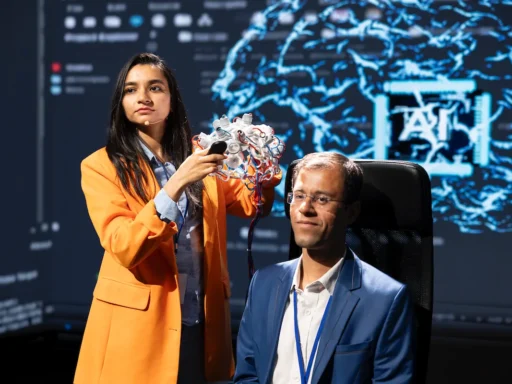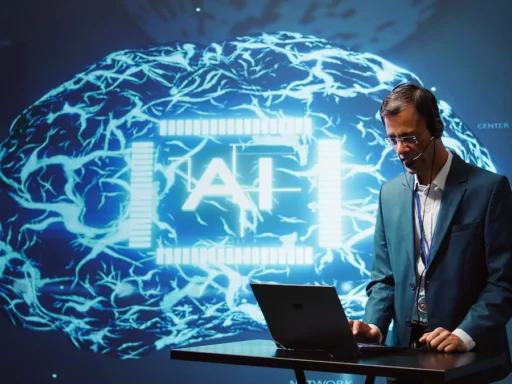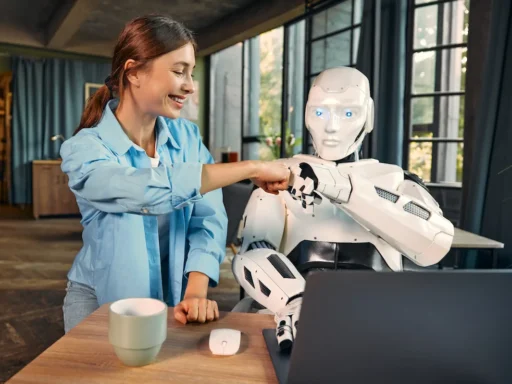If you’ve ever wondered why your AI app can sound smarter than your manager, or how robot arms are suddenly packing tomatoes like humans, here’s one reason: SoftBank. Yeah, the Japanese giant you probably associate more with telecoms than Terminators is trying to inject over $1 trillion into the American AI bloodstream.
Why?
Because building smarter AI takes more than algorithms—it takes hardware, talent, and infrastructure. And while Silicon Valley has the brainpower, SoftBank’s betting big that its wallet can buy the future.
We’re talking billions into AI labs, GPU factories, and data-crunching mega-centers fast enough to make your cloud bill break into a sweat. It’s not just about chatbots and factory robots—this is foundational stuff. Roads, power, and cooling towers for the next generation of artificial intelligence.
Their pitch?
Make the U.S. the global nerve center of AI.
It’s one of the largest corporate strategies in the tech world right now—but what’s the real plan?
Let’s get into it.
Inside SoftBank’s Vision To Build America’s AI Backbone
SoftBank isn’t dabbling.
They’re not here to fund cool demos or write hypey tweets.
This is long-term territory—think decades, not product launches. Their core play is simple: lay down the physical and digital infrastructure that AI needs to thrive, right on U.S. soil.
What’s that mean?
- Self-upgrading AI data centers powered by NVIDIA chips and tied into 5G/6G networks
- Autonomous factories and industrial parks where robot arms don’t take smoke breaks
- Venture cash pipelines for startups designing edge-AI, hardware integrations, and GPT-native tools
- National-scale partnerships with OpenAI, Oracle, and engineering schools to train future ML architects
Masayoshi Son, SoftBank’s founder, has been clear—this isn’t an experimental phase.
This is a pivot.
The company’s committing up to $1.1 trillion across several hands-on initiatives:
| Project | Investment Size | Main Focus |
|---|---|---|
| AI Infrastructure Plan | $100 Billion | Data centers, AI chips, robotics startups |
| Stargate Project | $500 Billion | Secured AI labs, GPT training centers (with OpenAI) |
| AI-Powered Industrial Parks | $1 Trillion | Autonomous manufacturing and robotics deployment |
This isn’t just a tech upgrade.
SoftBank wants to be the AWS of intelligent machines.
The key twist?
They’re doing it all in the U.S.
Why The U.S. Became Ground Zero For SoftBank’s AI Play
Let’s cut to it: If you want to turn AI into a utility—like electricity or roads—you go where scale is possible and talent is concentrated.
That’s the United States.
Here’s why the math works:
– The U.S. regulatory climate is loosening up again, especially under pro-infrastructure policies out of D.C.
– Silicon Valley isn’t just a brand. It’s loaded with the next generation of ML engineers, chip designers, and robotics visionaries.
– Access to bleeding-edge labs—from Stanford to OpenAI—lets SoftBank plug directly into the neural heart of innovation.
Masayoshi Son was already negotiating with local and federal agencies as early as 2024. The result? Streamlined permit approvals, tech-friendly tax incentives, and strategic alignment with American AI leadership goals.
And it’s not just about proximity to innovators.
It’s about power.
Chip fab facilities need clean water, steady electricity, and proximity to talent. That’s Phoenix, that’s Texas, that’s North Carolina.
Plus—let’s keep it real—SoftBank’s not a nonprofit.
They know the U.S. AI economy is expected to drive over $15 trillion in global value by 2030.
Why compete from the sidelines in Tokyo when you can own the server farms on U.S. soil?
So where venture capital used to flock to apps…
SoftBank is going all in on the stuff that makes apps possible.
They’re not betting on the next Snapchat.
They’re building the AIs that will replace PowerPoint.
And America is the testing ground.
Economic Impact of SoftBank’s AI Investments
How do trillion-dollar tech bets actually ripple through the economy? For SoftBank, the answer isn’t just profit margins or flashy headlines—it’s hundreds of thousands of new jobs, reshaped industrial workflows, and America’s standing in a global digital face-off with China. At the heart of SoftBank’s investment spree lies a bid to rebuild the backbone of AI from the ground up in the U.S.
AI job creation and market growth
SoftBank’s $100 billion AI infrastructure plan isn’t just about building data centers—it’s about workforce transformation. The company projects over 100,000 high-tech roles by 2028, covering fields like robotics, machine learning, secure networking, and data maintenance. These aren’t speculative jobs. They’re roles tied directly to shovel-in-the-ground projects and supply chain expansions across the country.
AI chip manufacturers are also preparing for a boom. With SoftBank injecting cash into GPU-heavy infrastructure and autonomous AI systems, experts forecast a sharp rise in demand for AI-specific semiconductors. According to industry data, the AI chip market—valued at $10.8 billion in 2021—is poised to hit $44.3 billion by 2025.
Boost to the AI economy
It’s easy to roll your eyes at trillion-dollar projections, but when you’re pumping hundreds of billions into AI training, robotics, and infrastructure, numbers begin to reshape reality. SoftBank is making direct contributions to the global AI economy, which PwC estimates could grow to $15.7 trillion by 2030. Instead of betting solely on consumer apps or VC bubbles, this investment targets real-world foundations: chips, data centers, fiber-optic networks.
SoftBank’s Stargate initiative—a $500 billion collaboration for AI supercomputing capabilities—acts as a catalytic engine. It’s structured to accelerate future tech beyond LLMs, enabling breakthroughs across sectors from defense to healthcare, via foundational data and compute access.
Supporting U.S. competitiveness in the digital transformation era
There’s a nationalistic undertone winding through SoftBank’s U.S. expansion. In an economic landscape where every superpower is racing to dominate AI infrastructure, strategic funding can flip the table. Between potential trade wars and rising geopolitical data tensions, this is more than capital—it’s a calculated push to make the U.S. less dependent on foreign compute power.
By closing gaps in AI hardware production and expanding humanoid robotics factories across American soil, SoftBank could give the U.S. a tangible lead in industrial modernization. These AI-enabled industrial parks don’t just support new tools—they redefine what factories produce and who works within them.
Case Studies: SoftBank’s Strategic AI Partnerships
SoftBank’s blueprint for AI supremacy isn’t solo. It’s stitched together through key collaborations—from labs developing model architectures to companies building the machinery to run them. These partnerships aren’t corporate window dressing—they represent a new type of AI public-private infrastructure deal.
Collaboration with NVIDIA
Imagine a robot that hears your voice and moves within milliseconds. That’s the premise behind SoftBank’s AI-RAN solution, deployed first at NVIDIA’s campus. By fusing intelligent telecom networks with AI edge processing, the project slashed latency to just 20 milliseconds—faster than the blink of an eye.
The goal? Create scalable, low-latency automation platforms for deployment in 5G environments, smart factories, and logistics hubs. These aren’t just speculative innovations; they’re live prototypes powering field robots in hospitals and server rooms already.
OpenAI funding and collaboration
In 2024, SoftBank dropped $500 million directly into OpenAI, becoming a pivotal stakeholder in its mission to develop next-gen GPT models. That wasn’t just an investment—it was a down payment on expansion.
Through the Stargate framework, OpenAI is slated to manage the operational core of AI supercenters, enabling model training at a planetary scale. These data centers will be optimized specifically for LLM development, turbocharging GPT-5 and its successors with high security and customized compute stacks.
Robotics and autonomous innovation parks driven by NVIDIA-GPU integration
Factories built like motherboards—this is SoftBank’s vision for the future of U.S. manufacturing. Each industrial park will operate with autonomous systems, fueled by NVIDIA GPUs and steered by AI algorithms. SoftBank isn’t just upgrading production—it’s flipping the switch on decades-old labor models.
Instead of relying on overstretched human workers, these parks leverage AI-driven arms and humanoid workers to address both efficiency and labor shortages. It’s a move that could reverse-shape U.S. industrial decline, making onshore rebuilding not just viable, but scalable.
SoftBank’s Long-Term Strategy for AI Growth
For Masayoshi Son, SoftBank’s founder, AI infrastructure is more than a tech trend—it’s the new electricity. What makes their strategy different is its depth: labs, capital, compute, and partners forming a system designed for decades, not product cycles.
Vision for the next decade of AI-driven innovation
SoftBank plans to build entire ecosystems focused on AI research and scalable commercialization. From funding core R&D labs to integrating AI into everything from logistics to national security, the company’s approach aims to embed intelligence into the fabric of American enterprise.
Behind this push is a clear goal: transition AI from isolated applications into everyday systems by aligning infrastructure, software development pipelines, and workers.
Venture capital as a growth engine
SoftBank’s strategy isn’t just about building behemoth data centers—it’s about seeding the soil. By funneling billions through Vision Fund 2 and future capital pools, it’s creating space for thousands of startups to scale innovations that traditional VC firms might overlook.
Instead of chasing short-term valuations, the fund prioritizes robotics, edge AI firmware, and chip design—domains with slower returns but higher national strategic value.
Future outlook
SoftBank USA is being positioned as the AI nerve center of the West. With a trillion-dollar blueprint in play, the company’s long-term strategy centers on creating unity between compute power, talent pipelines, and real-world impact.
If successful, the future will look less like Silicon Valley app culture and more like infrastructure renaissance. AI won’t just be behind the screen—it’ll be in hospital halls, warehouse aisles, and even air traffic control towers across the country. SoftBank’s ambition is not to dominate one piece of AI—it’s to own the foundation on which the rest runs.
Challenges and Risks in SoftBank’s AI Push
What happens when a corporation known for billion-dollar moonshots stakes its future on artificial intelligence in America? You get scale. You get speed. But you also get questions—ones that can’t be avoided anymore.
Let’s start with the big one: How do you fund a $1.1 trillion AI vision when you’re holding $27 billion in cash? That’s the reality SoftBank is facing. The numbers don’t lie. According to Q3 2024 financial records, the company confirmed just a fraction of what it needs, drawing on leveraged assets like ARM Holdings and heavy debt financing—$16 billion last March and another $8 billion queued for 2026. But if WeWork taught us anything, it’s that bold visions need more than bold checkbooks.
Masayoshi Son once poured billions into real estate coworking with dreams of urban utopias. That turned into a $14 billion loss. Critics haven’t forgotten. Which is why the same scrutiny now surrounds SoftBank’s AI investment pipeline. Execution strategy matters more than press releases.
On ethics, here’s the problem: AI systems like GPT models don’t just create—they reflect. Biases, misinformation, deepfakes—call them what they are: tools of influence, sometimes abuse. The bigger risk isn’t that machines become smarter than us, it’s what we teach them. Especially when SoftBank-backed projects like the Stargate centers plan to handle government-aligned data for national security and LLM development.
OpenAI’s own history shows what’s at stake. The company that once promised openness now gatekeeps its models while facing criticism over AI content manipulation. If SoftBank’s $500 million investment and $40 billion restructuring of OpenAI go through, the accountability stakes only rise.
And we haven’t even touched the layoffs. Autonomous factories, Nvidia GPUs powering humanoid robots, and robot porters that follow voice commands in milliseconds—cool for demos, scary for workers. The “Industrial Parks” funded by SoftBank are being sold as job creators. But let’s be real: robots don’t do overtime, don’t strike, and don’t retire. So who loses? The answer hangs heavy in union halls and American towns named in Masayoshi Son’s handshake tour across the Midwest.
Creating a Sustainable AI Ecosystem in the U.S.
If AI is going to change the game, we better make sure it doesn’t burn down the field. What America needs right now isn’t just faster chips and smarter robots—it’s a system that doesn’t leave humans in the dust while trillions flow through wires.
This starts with building an AI economy that lifts, not extracts. SoftBank’s aggressive funding could be that breakthrough—if it shifts toward long-term value. Instead of chasing flash-in-the-pan models, fund companies thinking 10 years out. Not the next TikTok filter startup, but builders solving food insecurity with prediction models or improving logistics for small-town retailers using AI.
Let’s talk partnerships. The most successful tech projects didn’t happen in a Silicon Valley vacuum. They happened when business, cities, and government aligned. SoftBank’s Stargate initiative—building national security-aligned data centers for OpenAI—only works if it wins federal trust. That means meeting environmental codes, zoning fast, and proving ethical guardrails.
Cities care about impact, not buzzwords. If SoftBank wants smooth rails for its $1 trillion industrial parks, partnering with local governments isn’t optional. It’s the whole game. Fast-tracked permits under Trump’s second term already opened doors. Don’t waste the access.
Then there’s the sustainability piece. You can’t scale AI just because you can—especially when training GPTs eats as much power as rural towns. SoftBank’s path forward must include:
- Green robotics only—no factory expansion without renewable-backed power
- Tracked overhead—data center emissions, water drawdowns, and energy consumption get logged and disclosed
- Labor equity—tracked wage equity across all roles (not just Stanford grads with Python on their résumé)
Change the culture before you pump in money. That’s the only way this doesn’t become another WeWork wrapped in silicon circuits.
Future Technologies and Digital Transformation
Let’s paint the real picture: AI isn’t just “software that thinks.” With SoftBank funding, it’s becoming the infrastructure that builds.
Imagine robotic fleets running American factories, guided by national Stargate supercenters pumping out real-time intelligence like veins in a digital nervous system. From autonomous forklifts to human-robot collaboration lines, this isn’t sci-fi—it’s SoftBank’s bet.
They’re not dipping toes. This is a cannonball. The pivot toward robotics solidifies Silicon Valley’s new priority: make machines work not just better, but instead. Every AI-powered system is a layer of friction removed from logistics, supply chains, and productivity—changing how jobs are done forever.
Beyond hardware, the software shift is massive. SoftBank’s roadmaps hint at quantum computing pilots, enterprise AI tools for predictive forecasting, and next-gen edge processing. This isn’t about replacing humans. It’s about reducing delays, errors, and cost spikes across the board—what every business quietly wants.
America, though, has to be more than just the sandbox. These investments shape our global standing. As China builds its own AI mega-cities, and the EU pushes heavy regulation, SoftBank steers the U.S. toward first-mover advantage through infrastructure dominance.
But dominance doesn’t mean safety. The moment AI becomes too automated without democratic oversight, it’s game over. Vision without governance is just velocity without brakes. Which is why every breakthrough needs a counterpart in ethics, environment, and hiring diversity—or this tech train derails before it reaches the next station.







